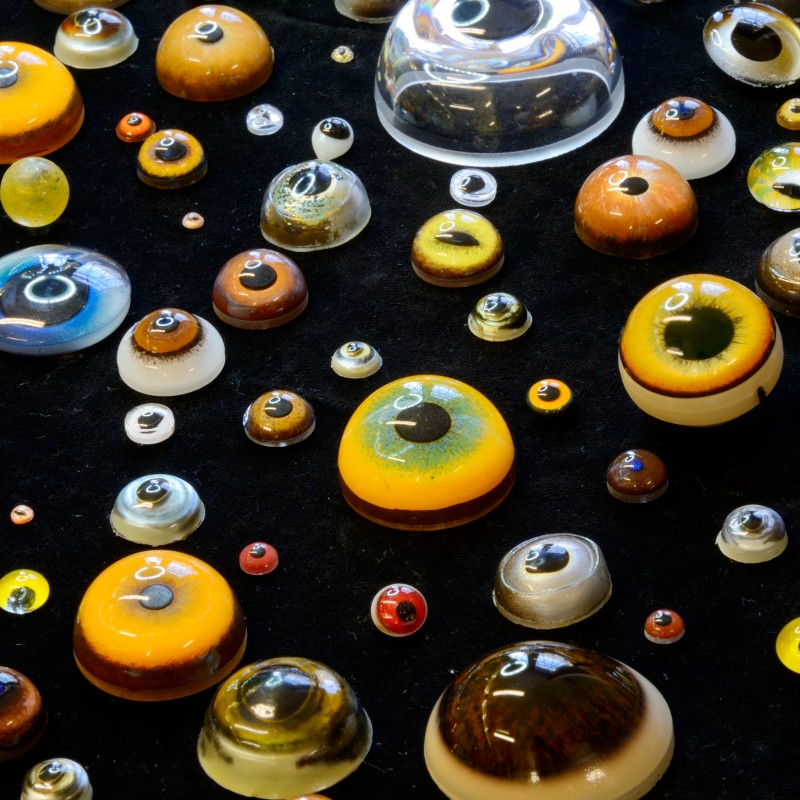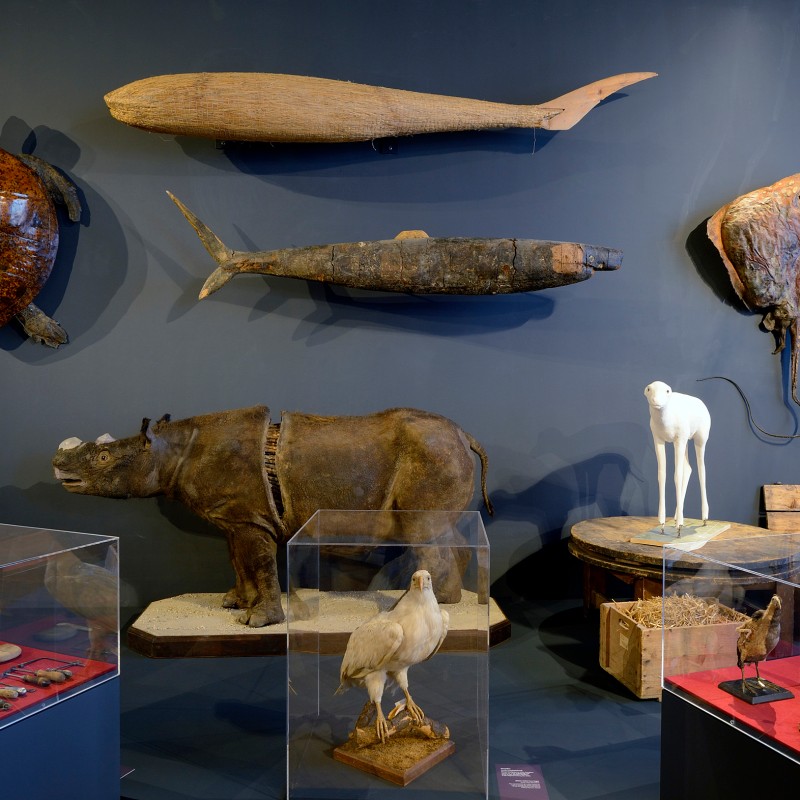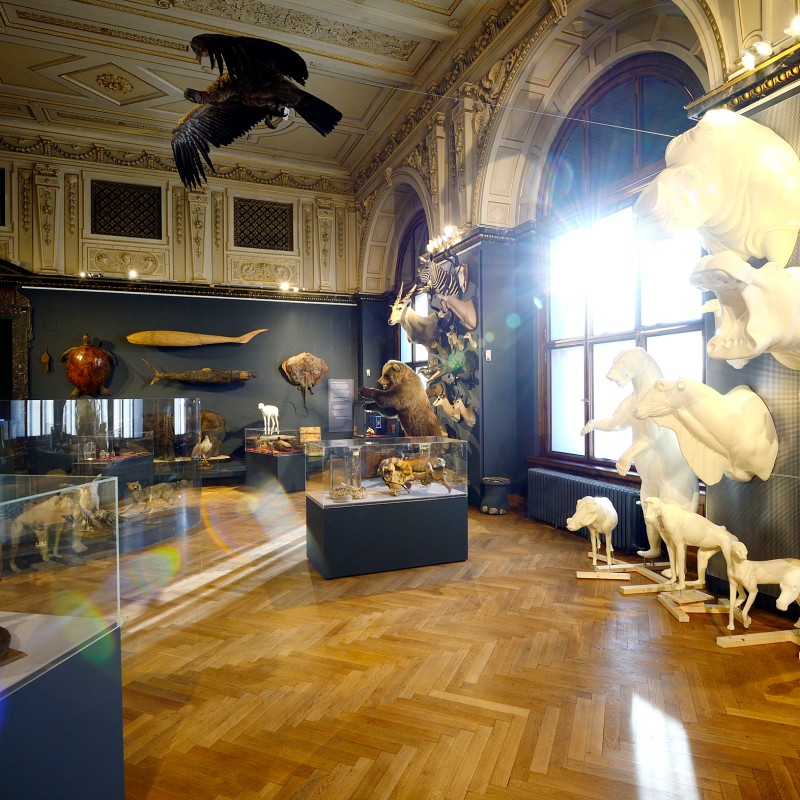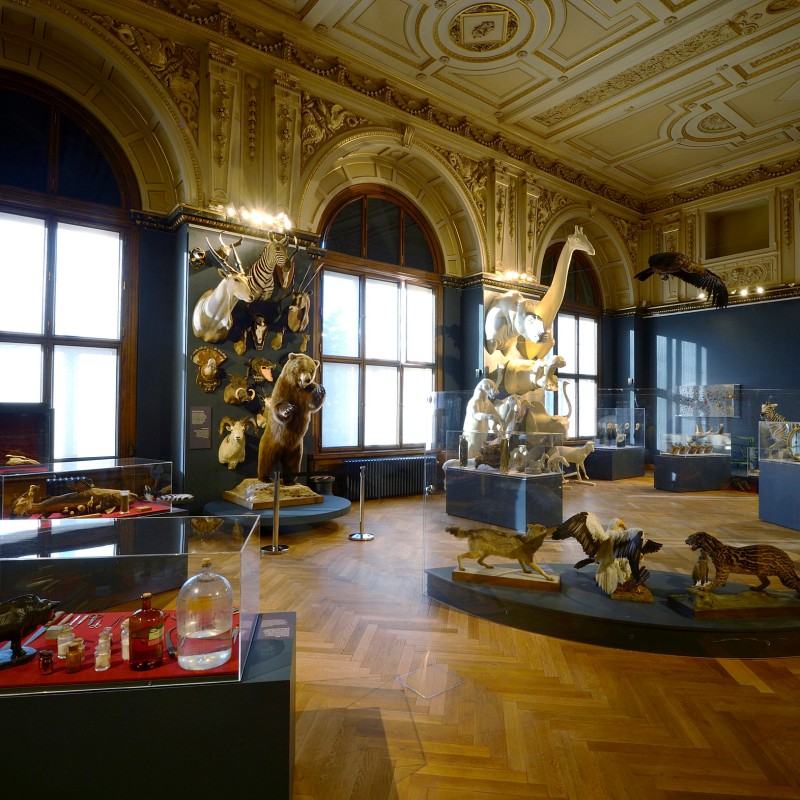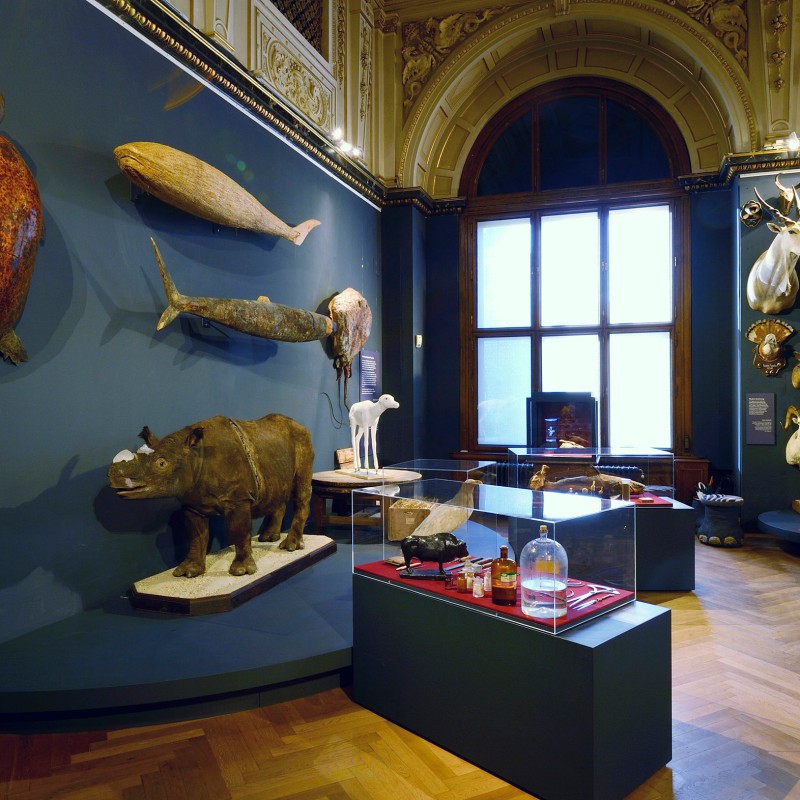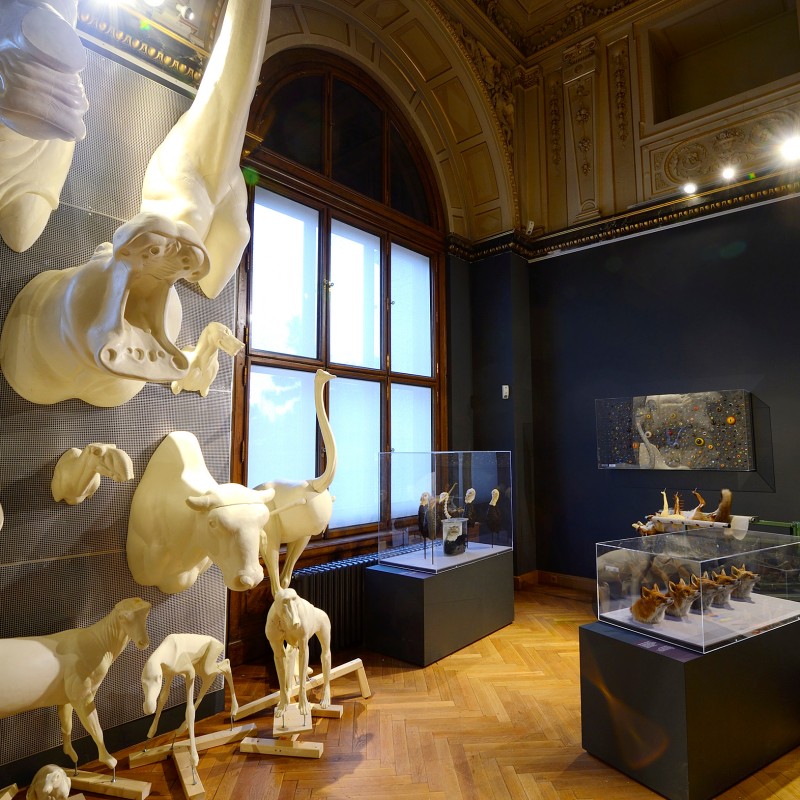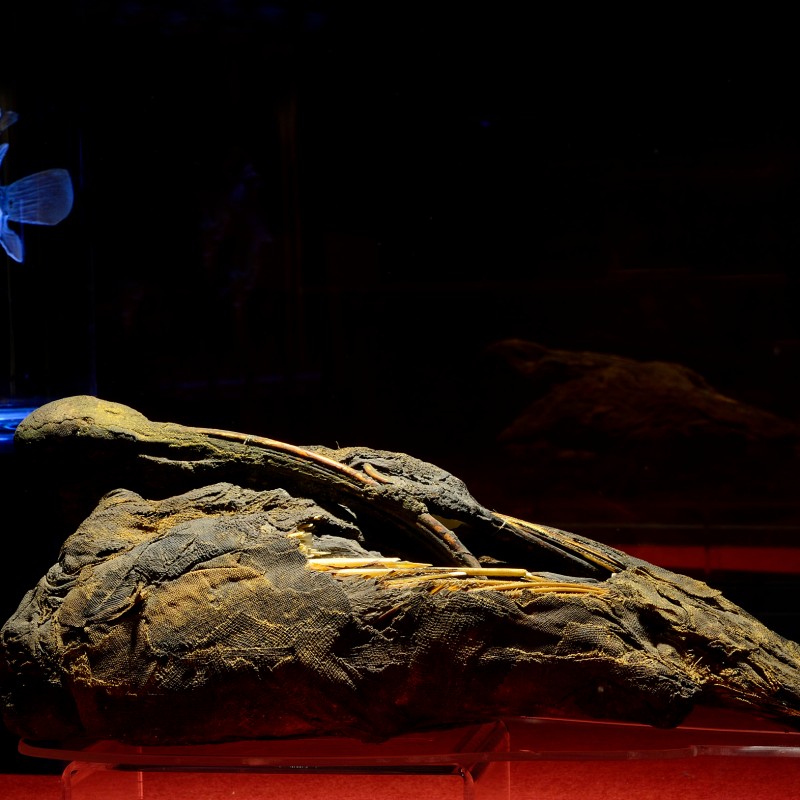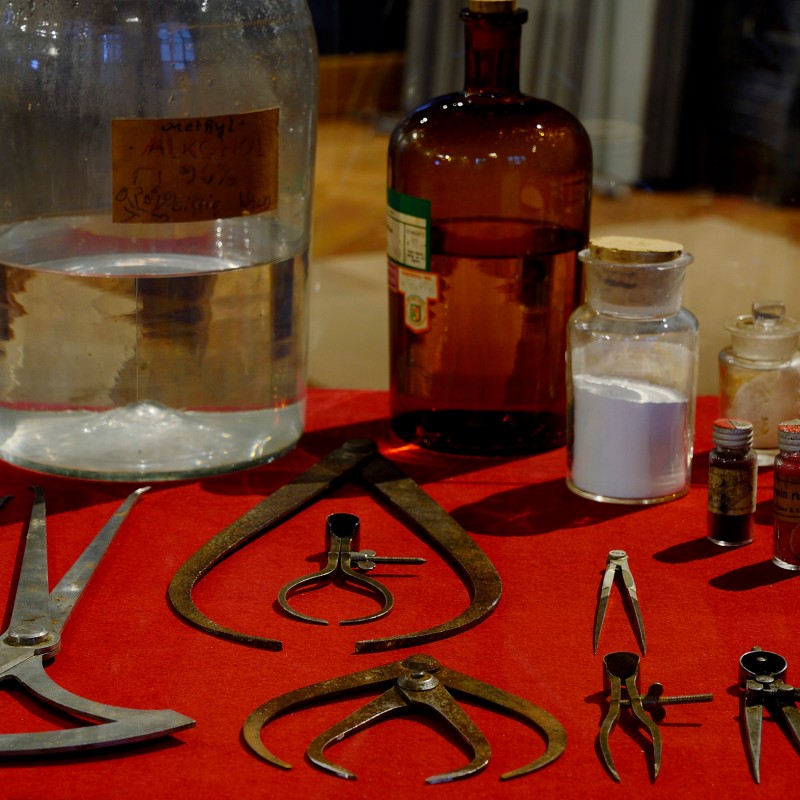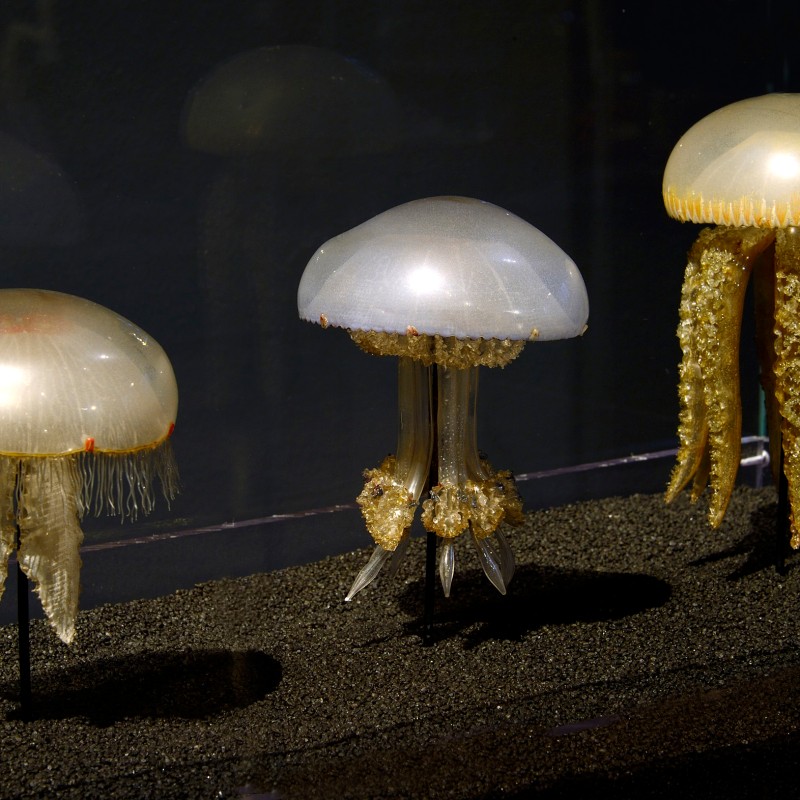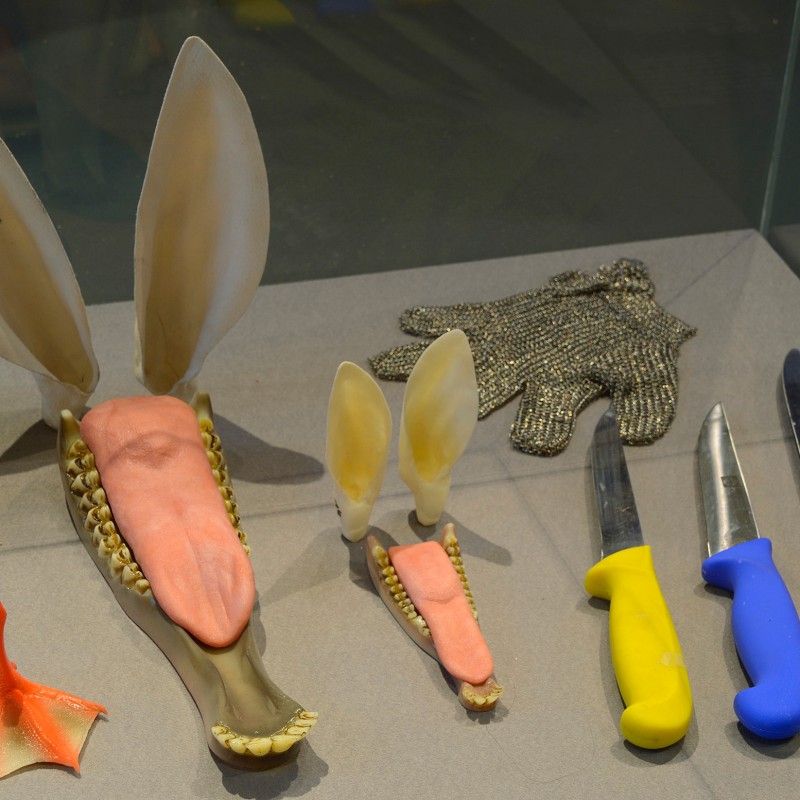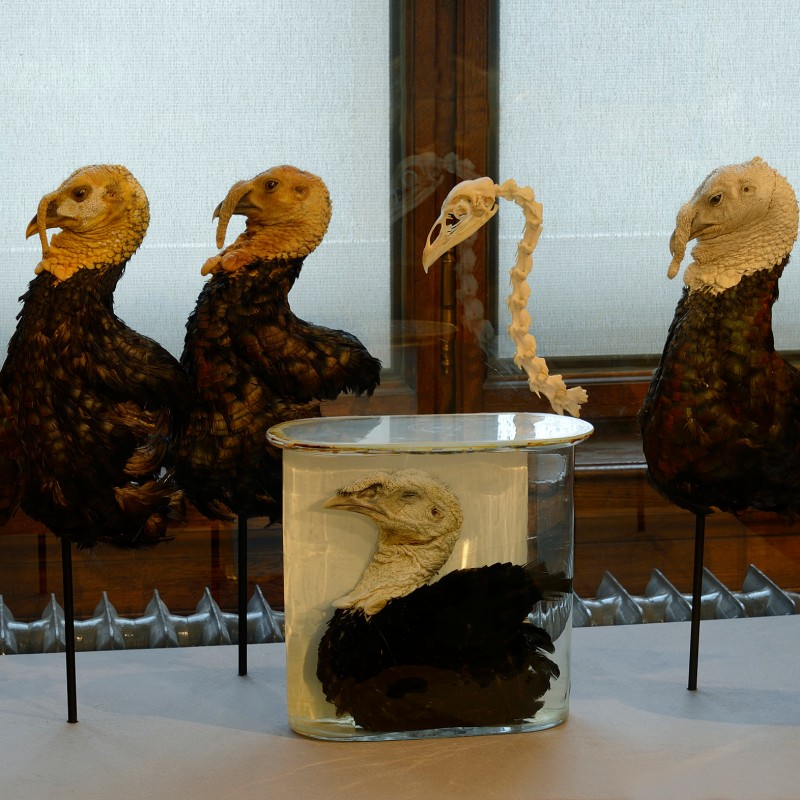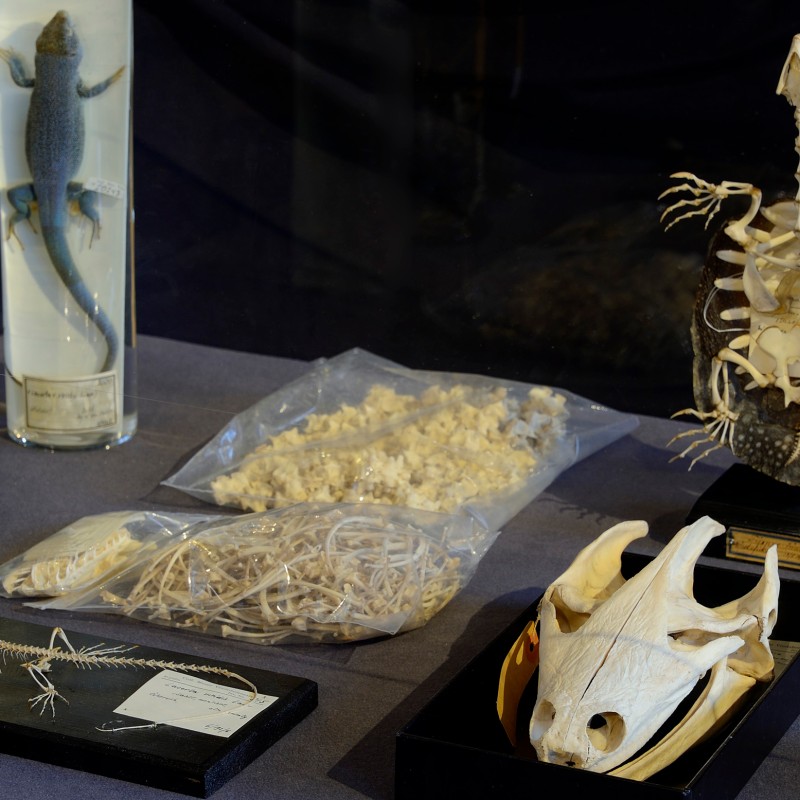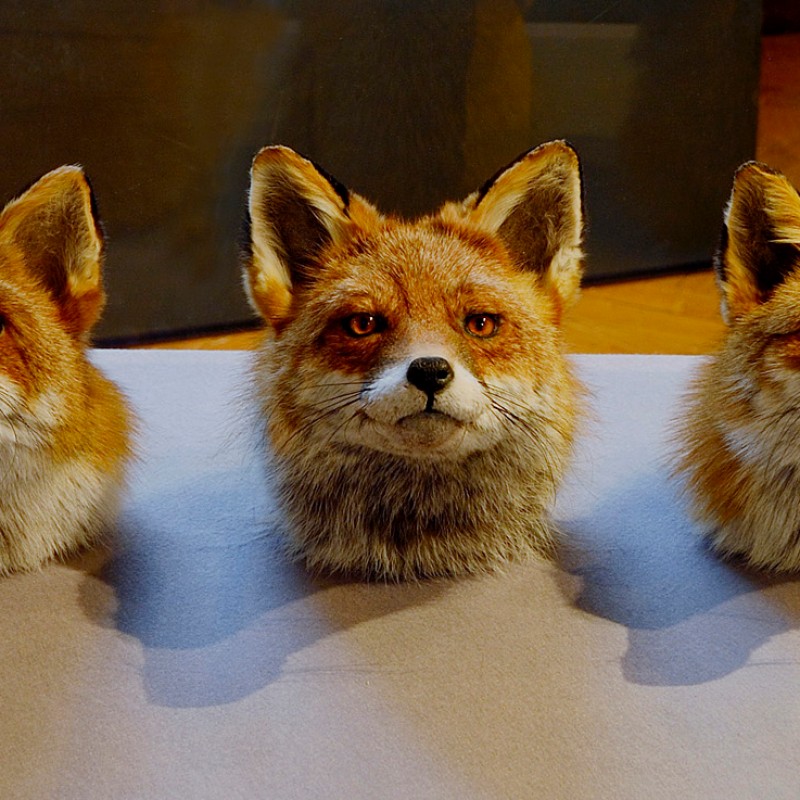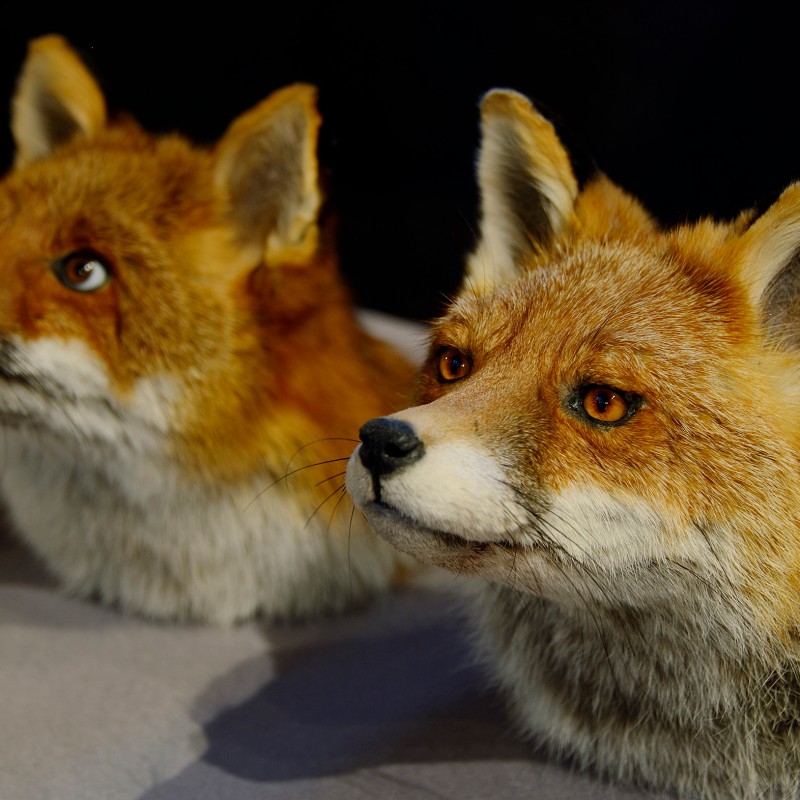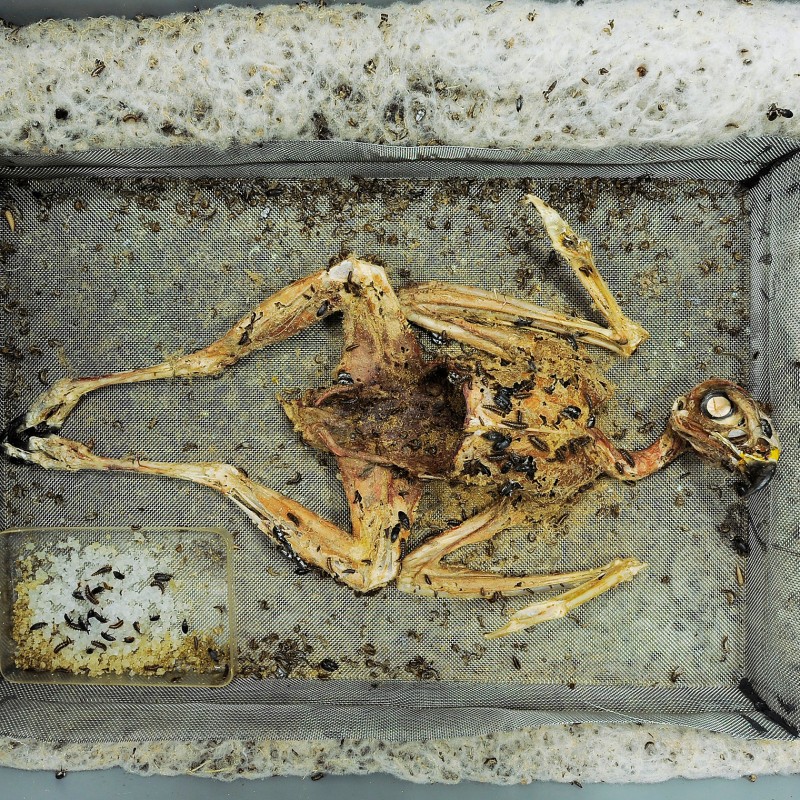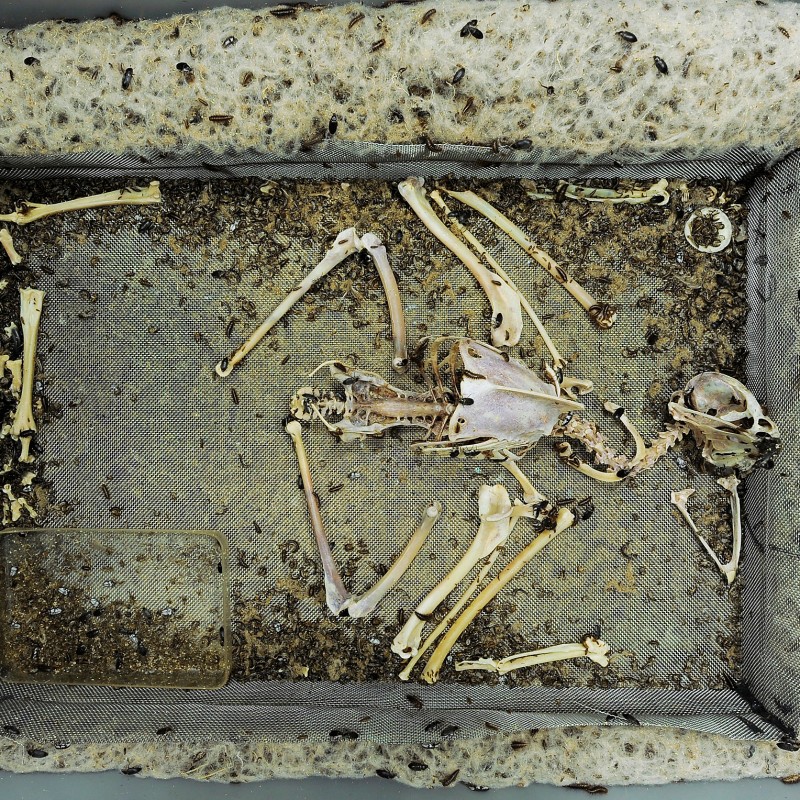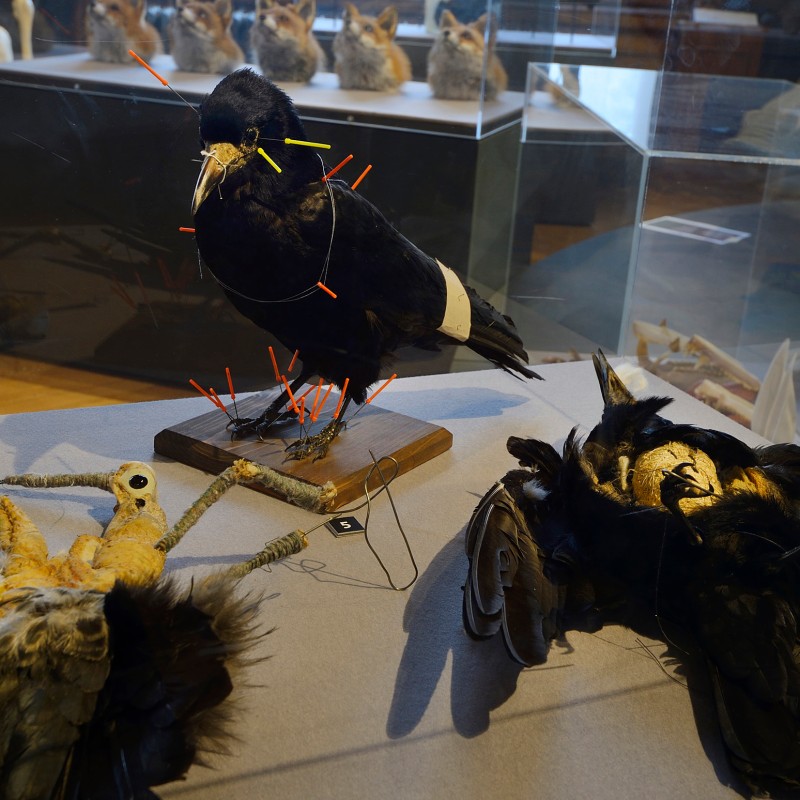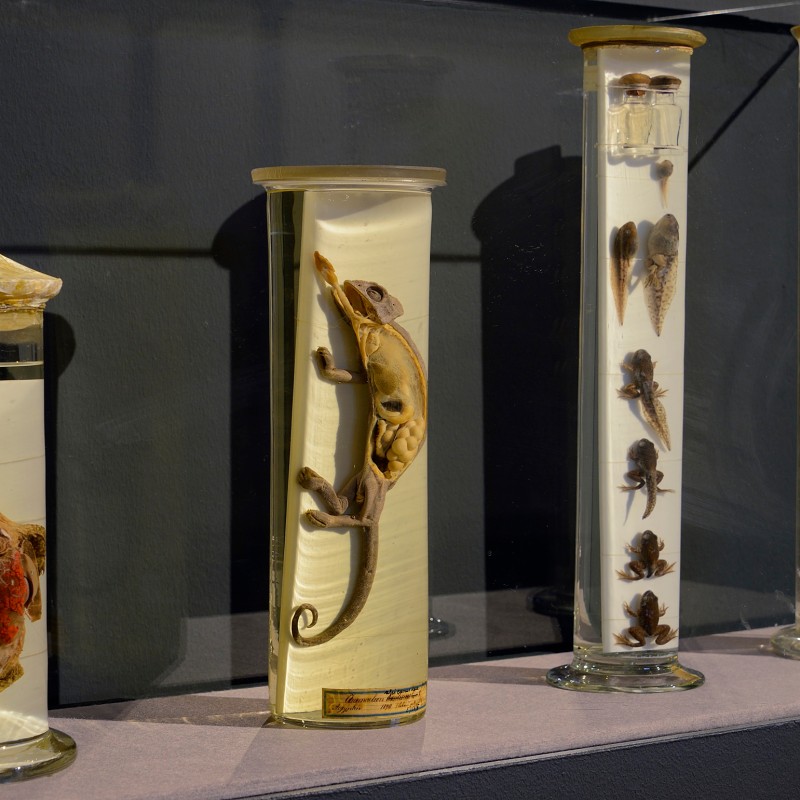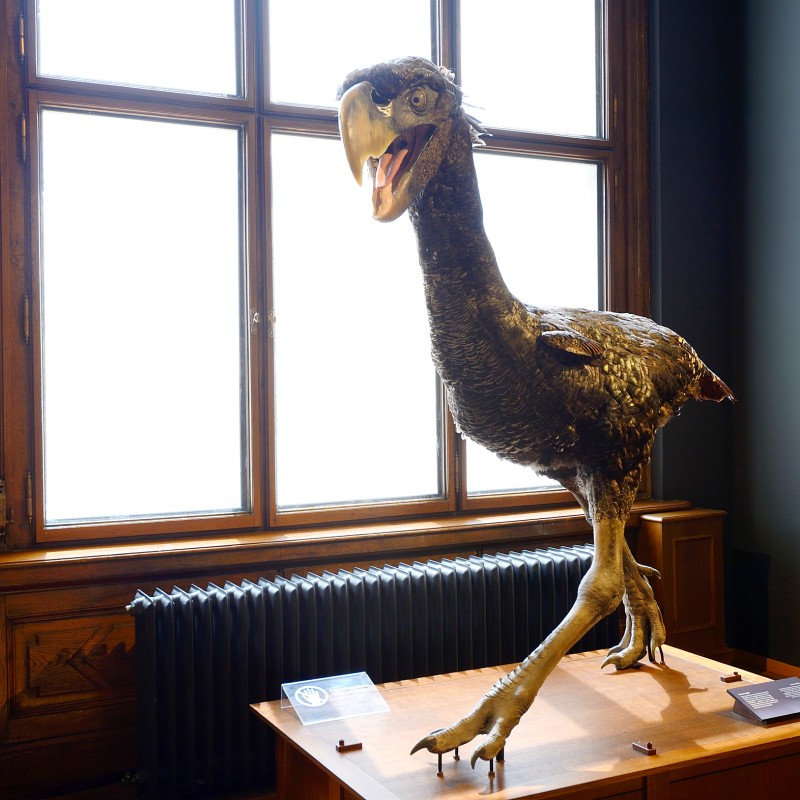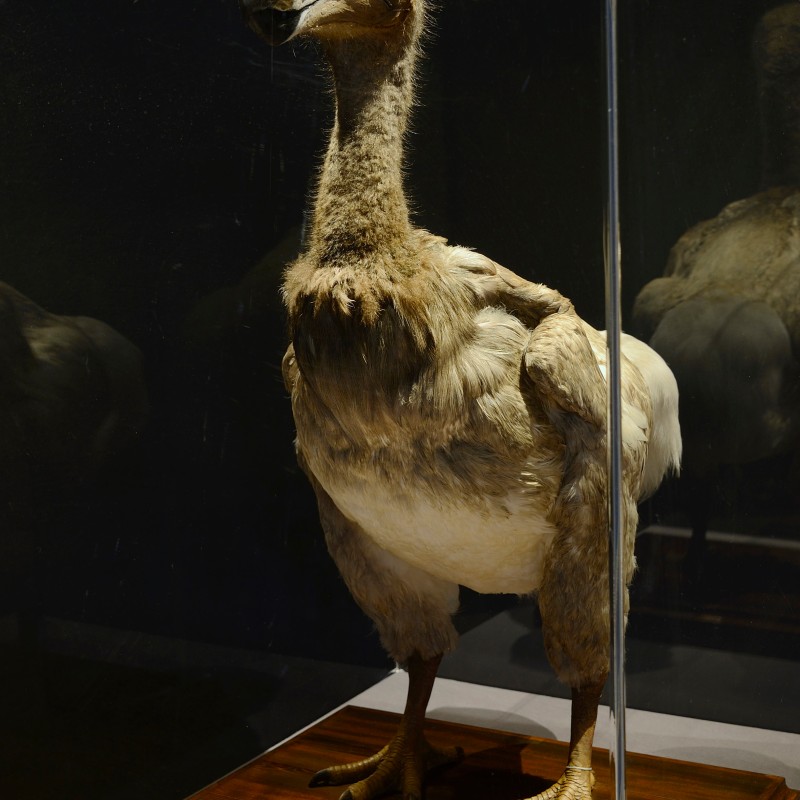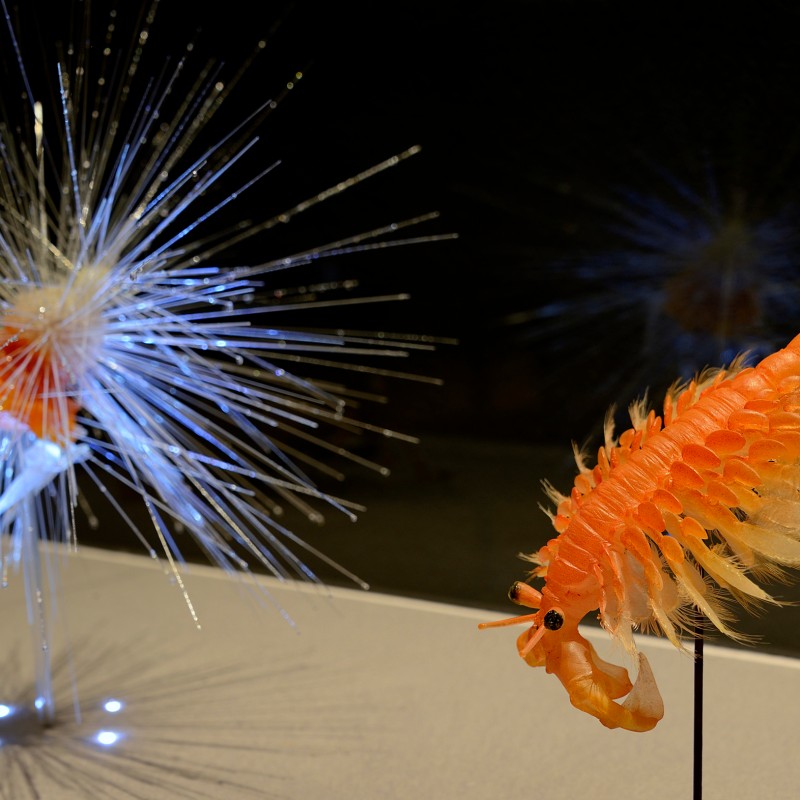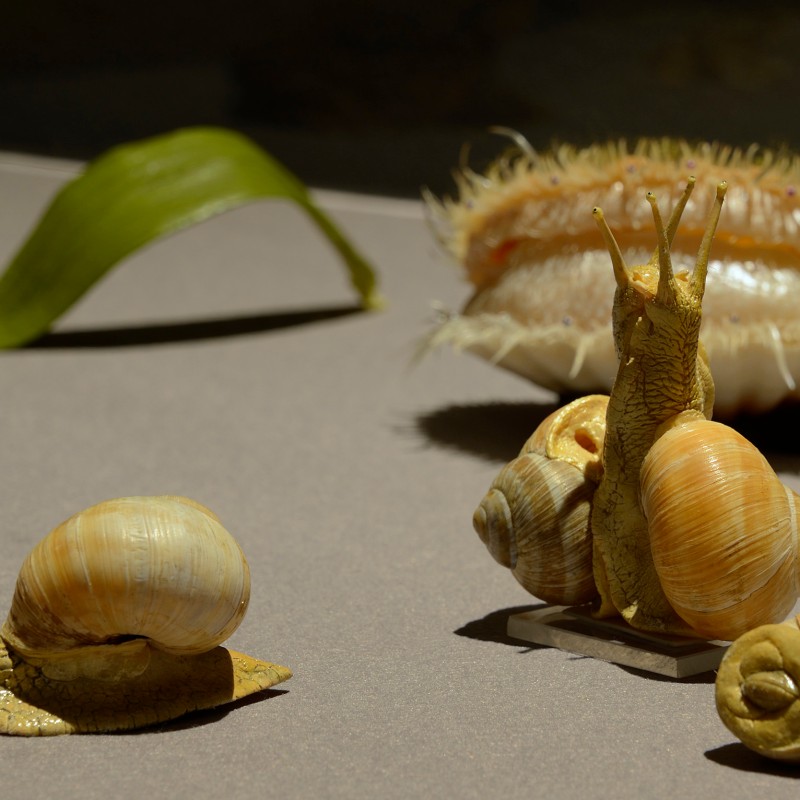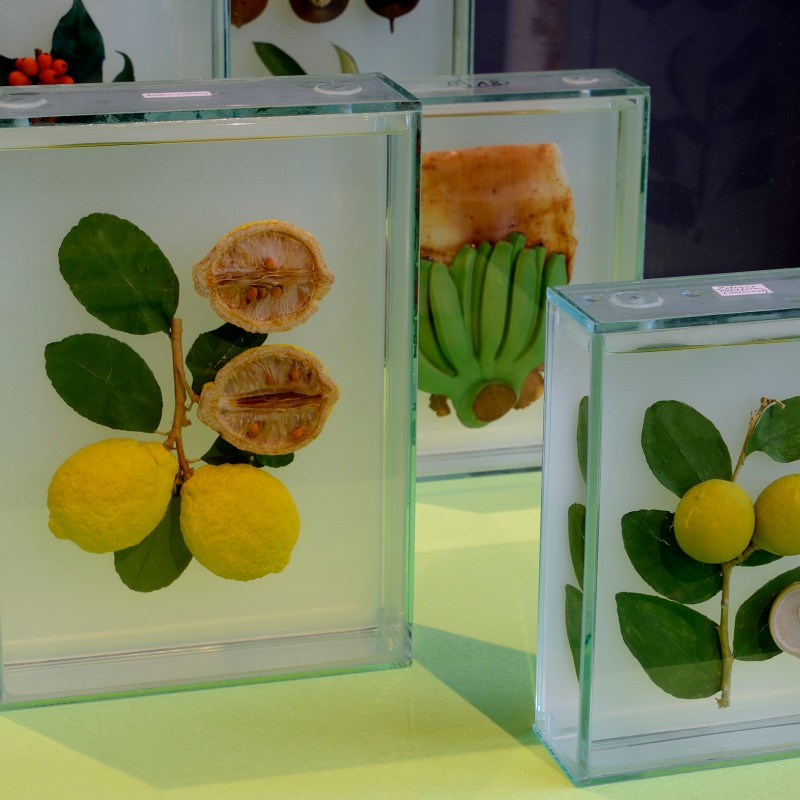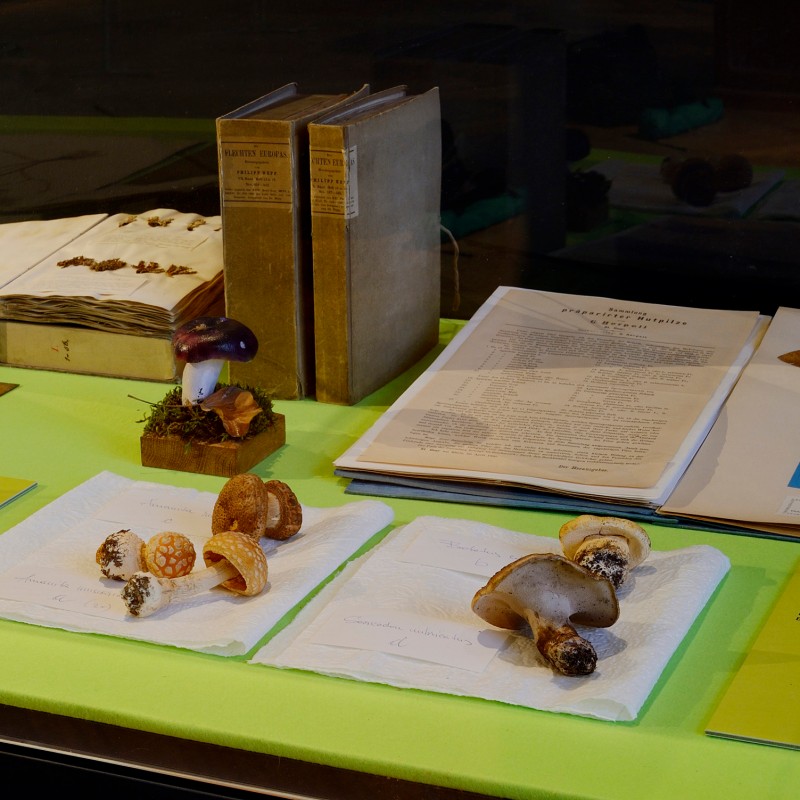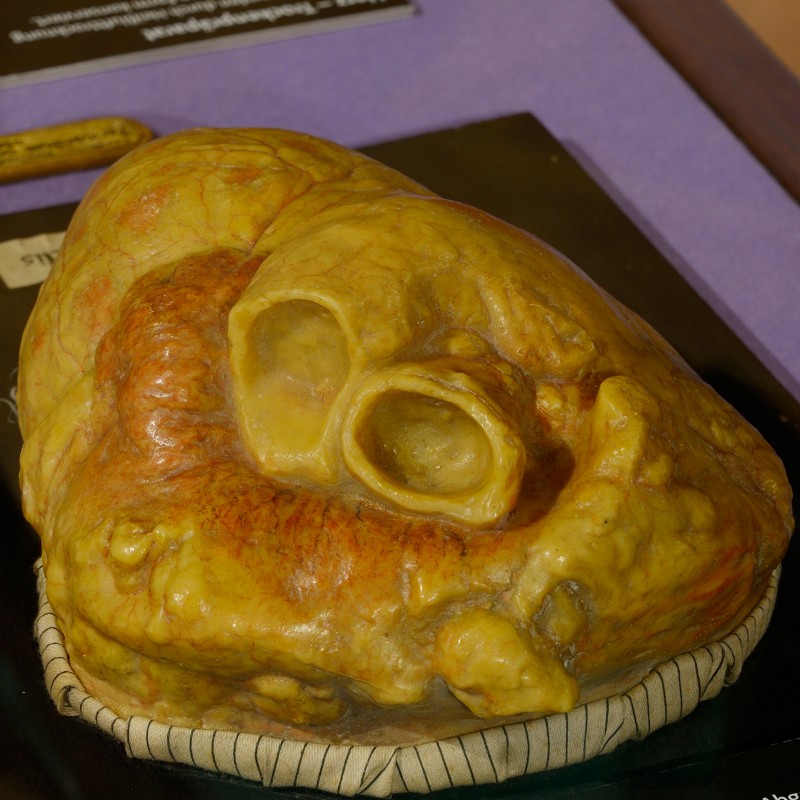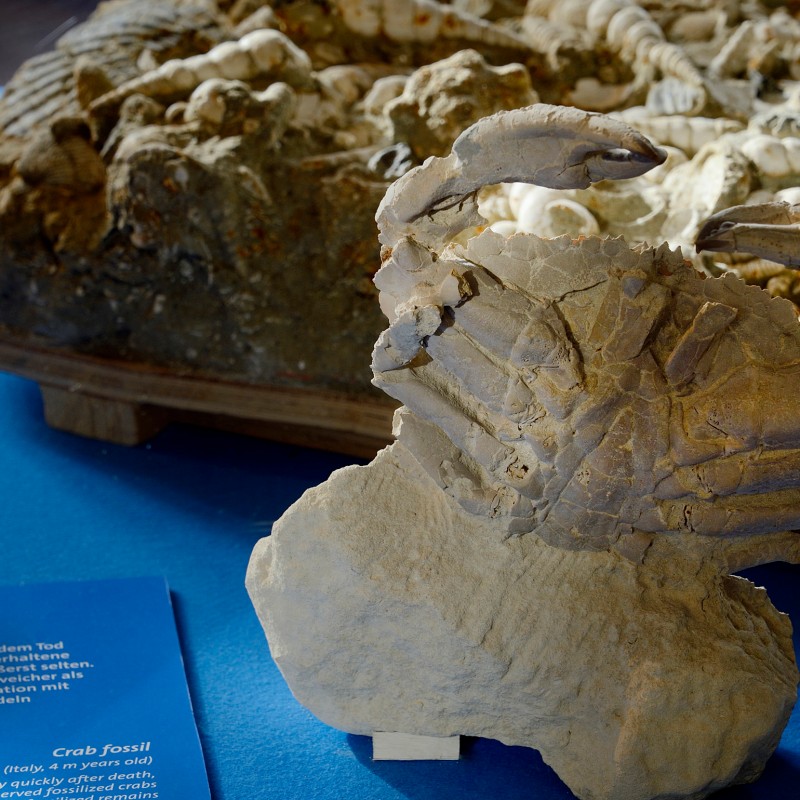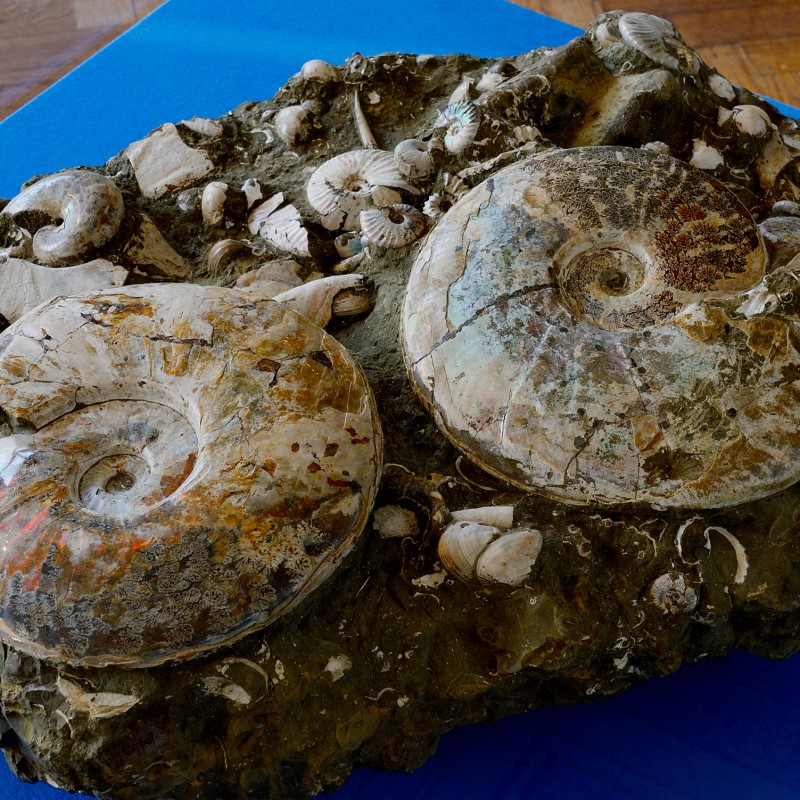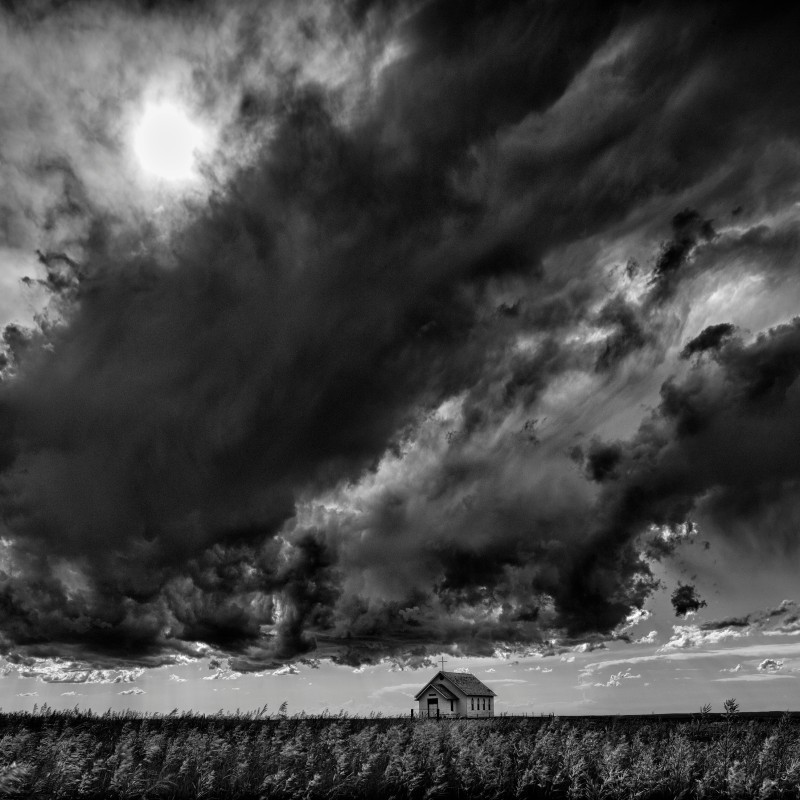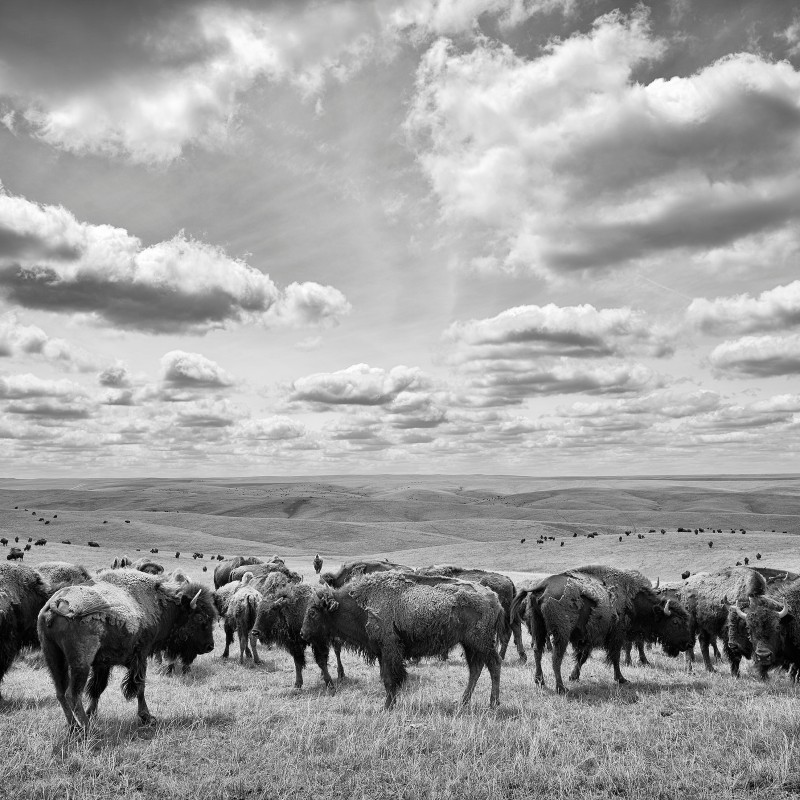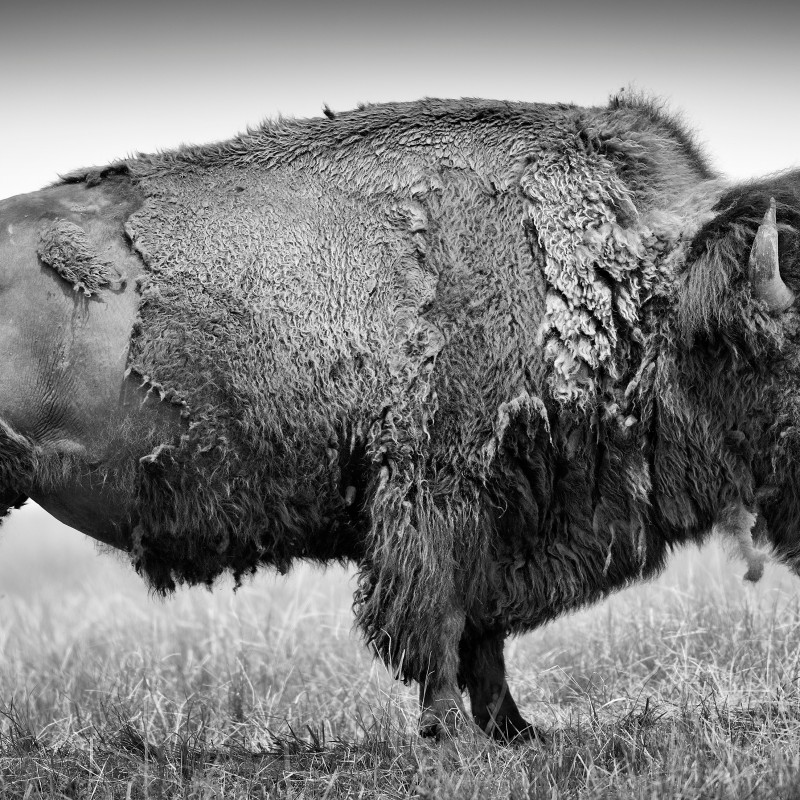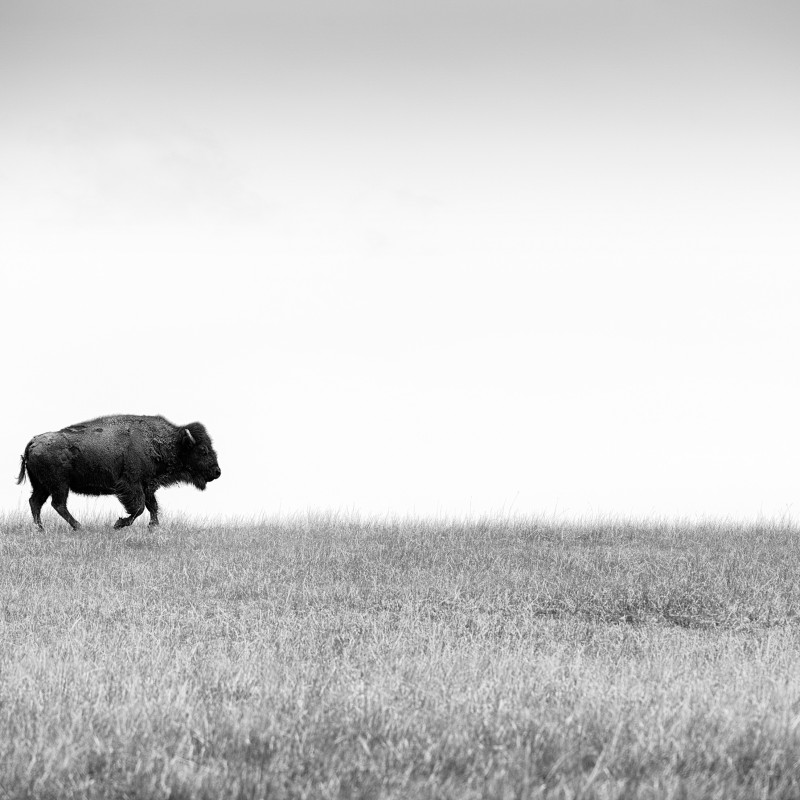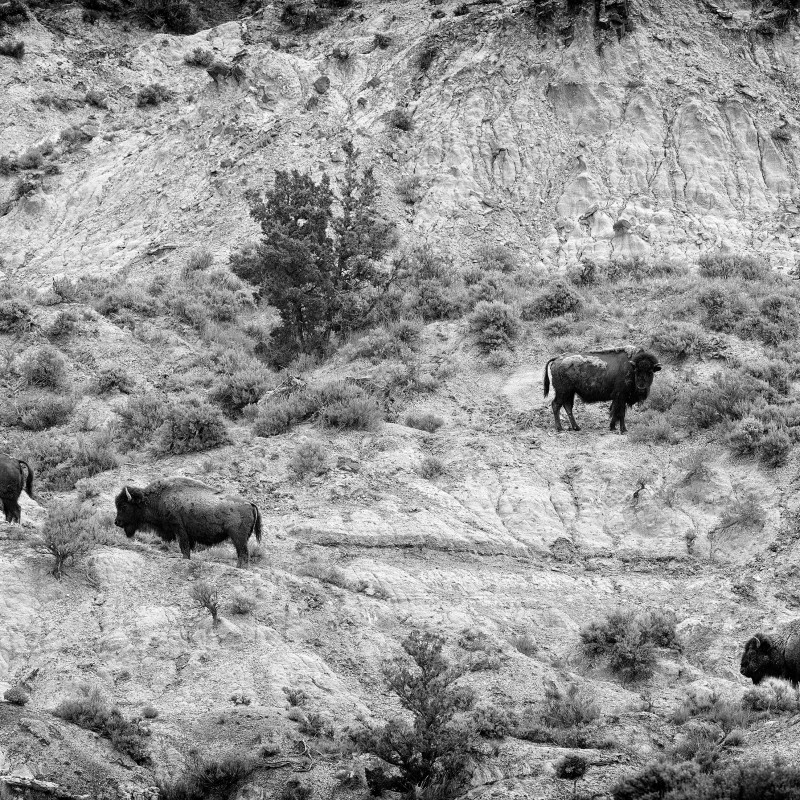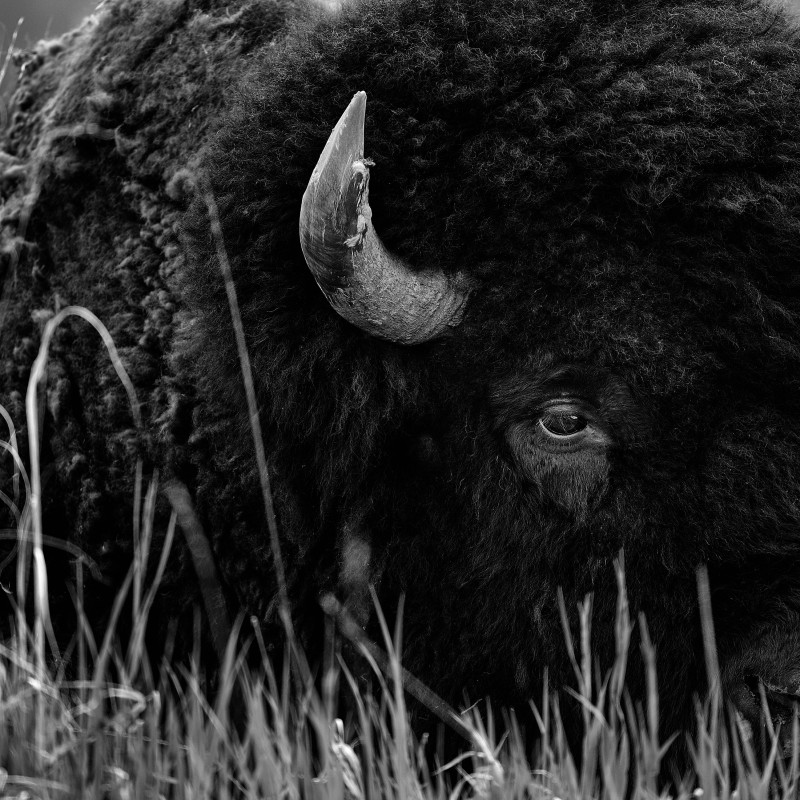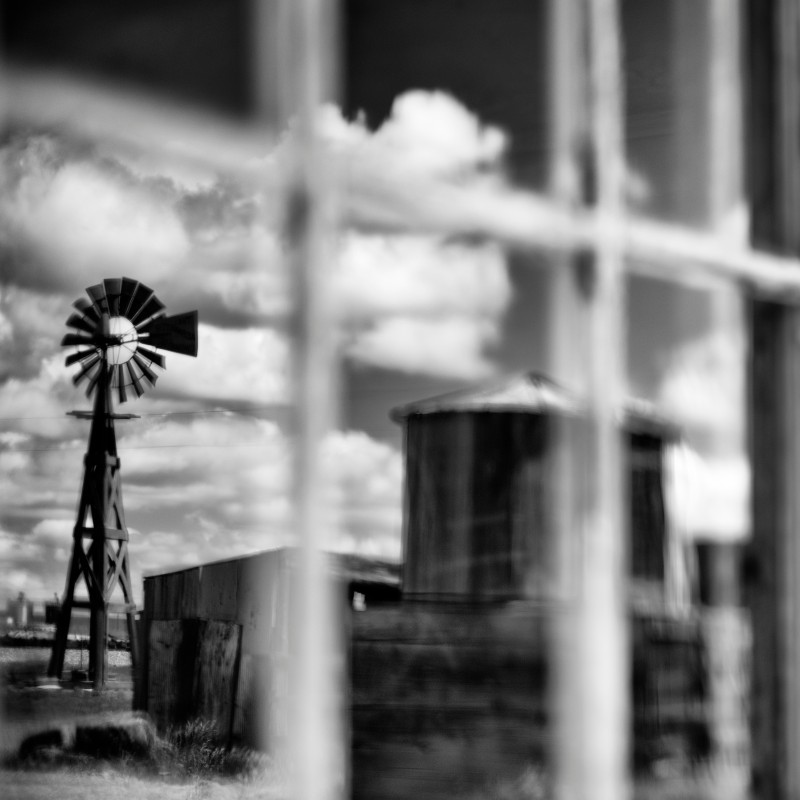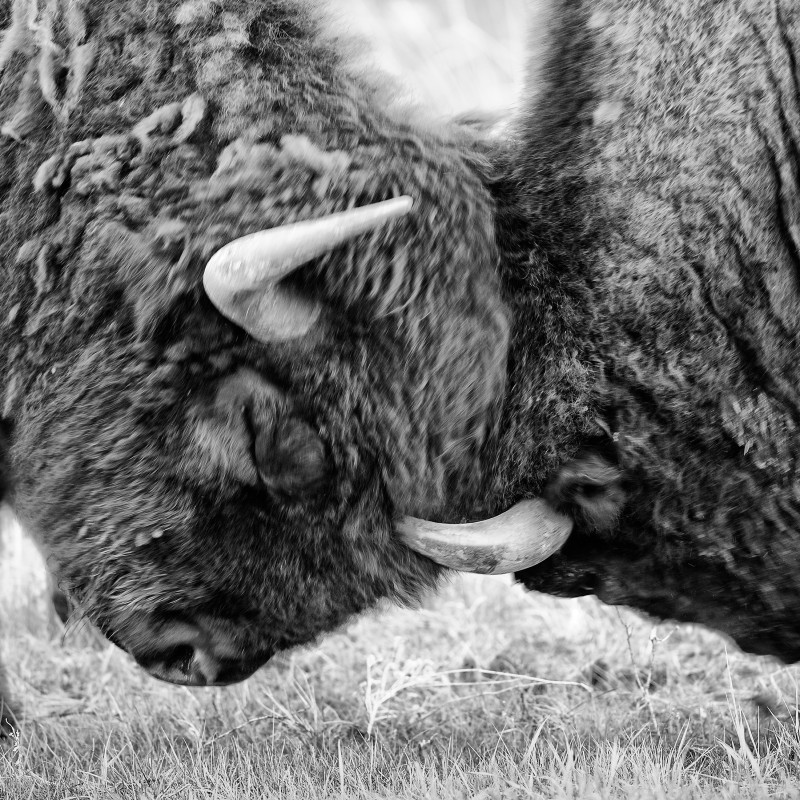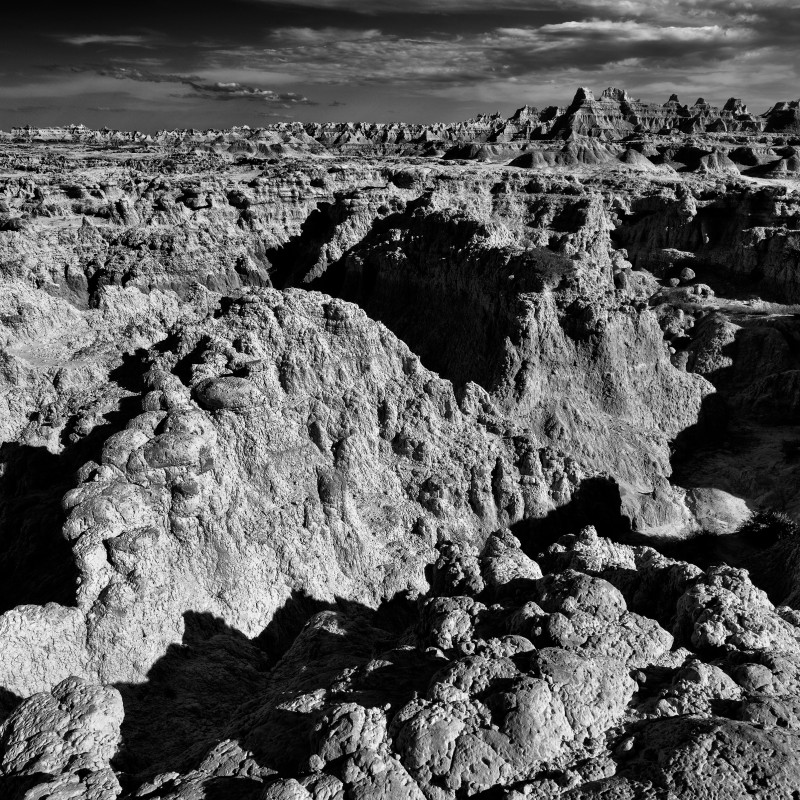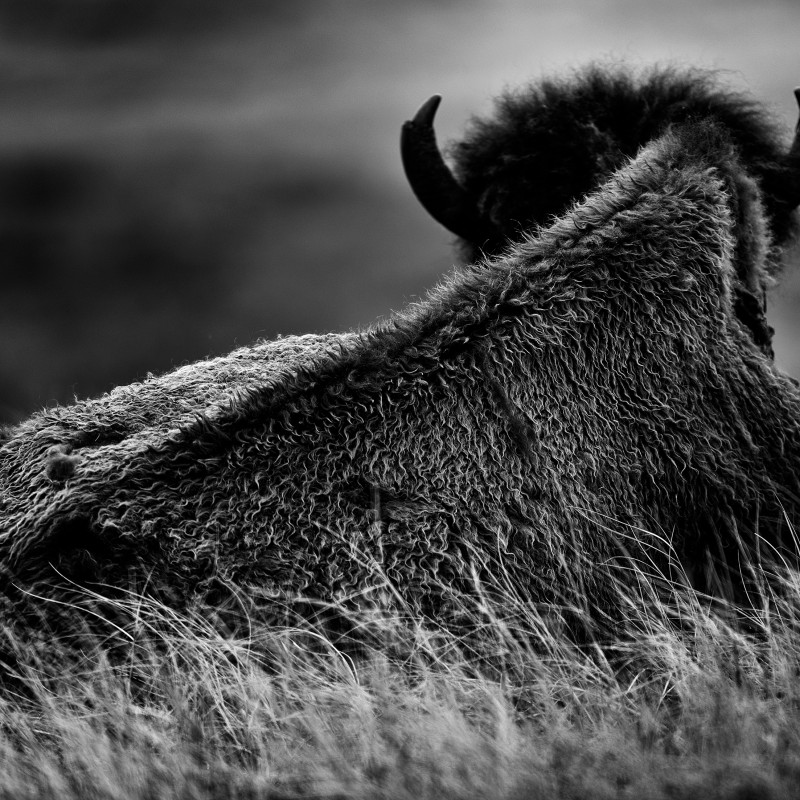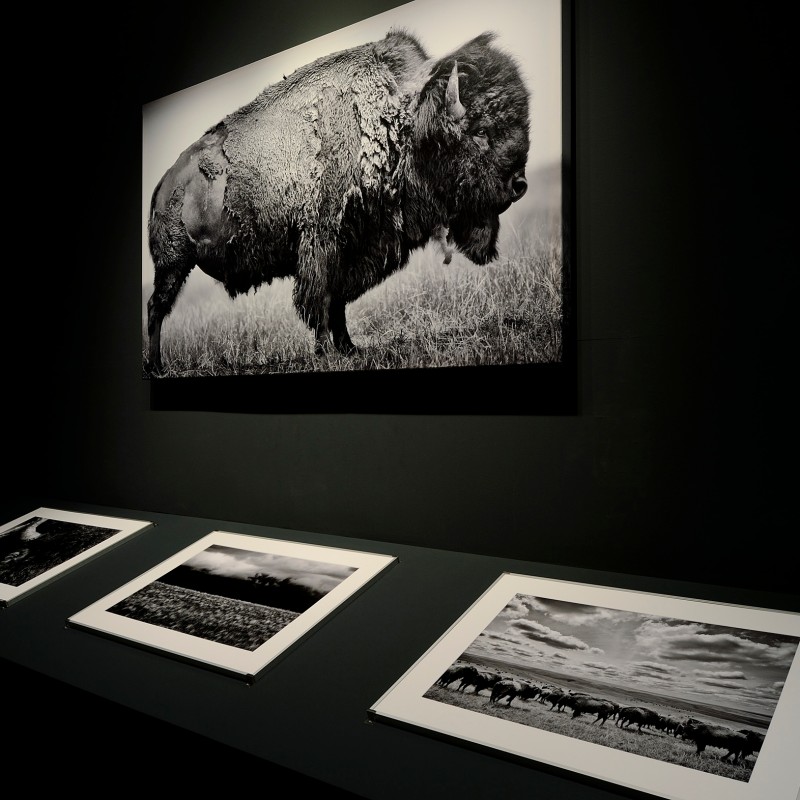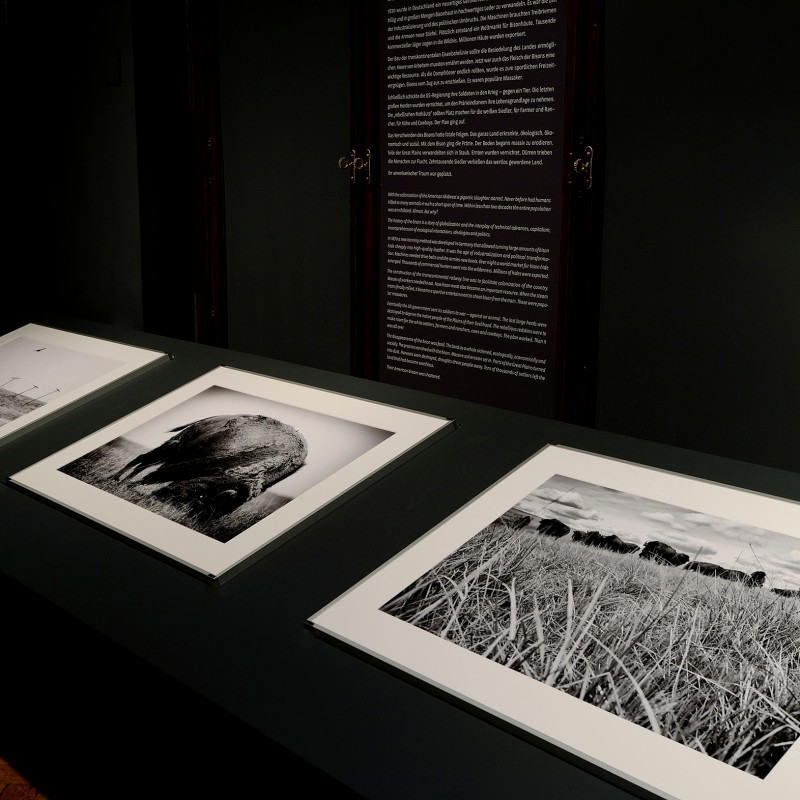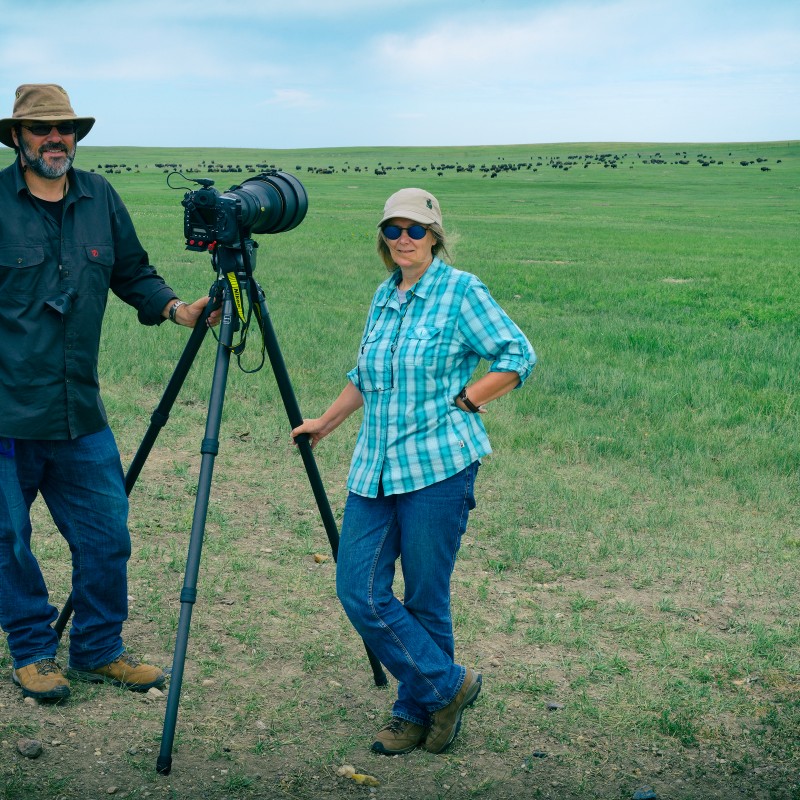THE WORLD OF TAXDMERMY AND PREPARATION // BUFFALO BALLAD
31. March 2015
Two new exhibitions at NHM Vienna
15.04. – 04.10.2015
15.04. – 04.10.2015
THE
WORLD OF TAXIDERMY
15.04. – 04.10.2015
Their work includes everything from cutting, chiseling, skinning and painting to carving artificial skeletons and dissecting organic structures. Their workshops are full of dust and often carry the smell of decay and solvents. Zoological, medical and paleontological taxidermists are masters of their craft and the backbone of any natural history museum. Now, the NHM Vienna has created a special exhibition dedicated to their work: “The World of Taxidermy”.
People have always striven to preserve living objects in pristine condition, as shown by the human and animal mummies of Ancient Egypt. From the 19th century onwards the demand for attractive hunting trophies grew, resulting in new conservation and taxidermy techniques. While these early objects are today of great historical value, they no longer meet the demands of modern taxidermy, which has little in common with the “stuffed” animals of the past. Instead, 21st century taxidermists employ state-of-the-art materials and techniques such as polyurethane foam and epoxy resins, cryogenic freezing and vacuum treatment, air brushing and precision instruments in order to achieve the same aim: to preserve as much as possible of the original, or to create a replica as lifelike as possible using modelling.
From 15 April until 4 October 2015, “The World of Taxidermy” special exhibition at the NHM Vienna will give visitors a fascinating insight into the 200-year-old history of taxidermy, revealing how the art of preservation has changed over the centuries and how model makers are today able to bring extinct species back to life.
BUFFALO BALLAD. Photographs by Heidi & Hans-Jürgen Koch
15.04 – 04.10.2015
“We traveled through the heart of bison country: North and South Dakota, Wyoming, Colorado and Montana. Our view of the bison is neither romantic nor nostalgic – it shows in equal measures the past, the present and the future of the American prairie.” Heidi & Hans-Jürgen Koch
Buffalo Ballad is a quest for the spirit of this iconic American animal. Captured on their travels through the heart of bison country, Heidi & Hans-Jürgen Koch’s black-and-white photographs turn the mythical bison into a tangible vision. “There must be places out there where archaic creatures can roam free. Only a world where that is possible is a world worth living in,” explain the artists.
It is estimated that in the 16th century more than 30 million American bison made the journey across the grassy plains between Canada and Mexico and from the Rocky Mountains to the Mississippi. As they moved, their thick coats formed a pulsating dark ocean permanently in motion. The arrival of settlers in the Midwest marked the start of their demise. Never before in the history of humankind had man killed so many animals in such a short period of time. Within just two decades the bison population was decimated, with just a few animals surviving. The history of the bison tells the story of globalization and how technical progress, capitalism, ignorance of environmental interdependence, ideologies and politics interweave. The bison symbolizes the American soul. By sending cavalry soldiers to protect the last remaining bison, Theodor Roosevelt became the forefather of animal conservation in the US.
Today, bison are being reintroduced as part of the long-term project “Buffalo Commons”. One of the aims is to counteract the increasing desertification of the Great Plains, where the Dust Bowl years of the 1930s saw tens of thousands of settlers forced to leave the arid land that had become worthless. According to the project organizers, a return to hundreds of thousands of bison roaming the plains would help the region to recover – ecologically, economically and socially.
Heidi and Hans-Jürgen Koch studied social work and behavioral science before becoming professional photographers over 25 years ago. The many images they have had published in some of the world’s most renowned magazines reflect their passion and skill.
15.04. – 04.10.2015
Their work includes everything from cutting, chiseling, skinning and painting to carving artificial skeletons and dissecting organic structures. Their workshops are full of dust and often carry the smell of decay and solvents. Zoological, medical and paleontological taxidermists are masters of their craft and the backbone of any natural history museum. Now, the NHM Vienna has created a special exhibition dedicated to their work: “The World of Taxidermy”.
People have always striven to preserve living objects in pristine condition, as shown by the human and animal mummies of Ancient Egypt. From the 19th century onwards the demand for attractive hunting trophies grew, resulting in new conservation and taxidermy techniques. While these early objects are today of great historical value, they no longer meet the demands of modern taxidermy, which has little in common with the “stuffed” animals of the past. Instead, 21st century taxidermists employ state-of-the-art materials and techniques such as polyurethane foam and epoxy resins, cryogenic freezing and vacuum treatment, air brushing and precision instruments in order to achieve the same aim: to preserve as much as possible of the original, or to create a replica as lifelike as possible using modelling.
From 15 April until 4 October 2015, “The World of Taxidermy” special exhibition at the NHM Vienna will give visitors a fascinating insight into the 200-year-old history of taxidermy, revealing how the art of preservation has changed over the centuries and how model makers are today able to bring extinct species back to life.
BUFFALO BALLAD. Photographs by Heidi & Hans-Jürgen Koch
15.04 – 04.10.2015
“We traveled through the heart of bison country: North and South Dakota, Wyoming, Colorado and Montana. Our view of the bison is neither romantic nor nostalgic – it shows in equal measures the past, the present and the future of the American prairie.” Heidi & Hans-Jürgen Koch
Buffalo Ballad is a quest for the spirit of this iconic American animal. Captured on their travels through the heart of bison country, Heidi & Hans-Jürgen Koch’s black-and-white photographs turn the mythical bison into a tangible vision. “There must be places out there where archaic creatures can roam free. Only a world where that is possible is a world worth living in,” explain the artists.
It is estimated that in the 16th century more than 30 million American bison made the journey across the grassy plains between Canada and Mexico and from the Rocky Mountains to the Mississippi. As they moved, their thick coats formed a pulsating dark ocean permanently in motion. The arrival of settlers in the Midwest marked the start of their demise. Never before in the history of humankind had man killed so many animals in such a short period of time. Within just two decades the bison population was decimated, with just a few animals surviving. The history of the bison tells the story of globalization and how technical progress, capitalism, ignorance of environmental interdependence, ideologies and politics interweave. The bison symbolizes the American soul. By sending cavalry soldiers to protect the last remaining bison, Theodor Roosevelt became the forefather of animal conservation in the US.
Today, bison are being reintroduced as part of the long-term project “Buffalo Commons”. One of the aims is to counteract the increasing desertification of the Great Plains, where the Dust Bowl years of the 1930s saw tens of thousands of settlers forced to leave the arid land that had become worthless. According to the project organizers, a return to hundreds of thousands of bison roaming the plains would help the region to recover – ecologically, economically and socially.
Heidi and Hans-Jürgen Koch studied social work and behavioral science before becoming professional photographers over 25 years ago. The many images they have had published in some of the world’s most renowned magazines reflect their passion and skill.
“The World of Taxidermy” exhibition - Collection of glass eyes for vertebrates
© NHM Wien, Kurt Kracher
Early examples of taxidermy: mummified ibis and basilisk
Die ältesten Tierpräparate wurden vor mehr
als 3.000 Jahren in Ägypten angefertigt. In der Renaissance wurden „Wunderkammern“ europäischer Fürsten mit Fantasiegebilden
wie Basilisken bestückt. Hier wurde ein Rochen zum Fabelwesen.
Mummified animals from Ancient Egypt dating back more than 3000 years are the oldest examples of taxidermy. During the Renaissance period, ruling princes across Europe added fantastical creations such as basilisks to their “Chambers of Wonder”. This ray has been transformed into such a mythical creature.
© NHM Wien, Kurt Kracher
Mummified animals from Ancient Egypt dating back more than 3000 years are the oldest examples of taxidermy. During the Renaissance period, ruling princes across Europe added fantastical creations such as basilisks to their “Chambers of Wonder”. This ray has been transformed into such a mythical creature.
© NHM Wien, Kurt Kracher
Early taxidermy techniques
Modelliertische kamen in der Frühzeit der Tierpräparation zum Einsatz. Ab
ca. 1850 stieg die Nachfrage nach Präparaten, als Jagdtrophäe oder auch für die frühen Naturmuseen. Die Werkstätten glichen
Hexenküchen, in denen neben Ton, Gips und Stroh auch Gifte wie Arsen großzügig verwendet wurden.
Modelling tables were used in early taxidermy. From 1850 onwards demand for such specimens grew, either as hunting trophies or for early museums of natural science. Taxidermists’ workshops resembled witches’ kitchens – as well as clay, plaster and straw, poisons such as arsenic were used in large quantities.
© NHM Wien, Kurt Kracher
Modelling tables were used in early taxidermy. From 1850 onwards demand for such specimens grew, either as hunting trophies or for early museums of natural science. Taxidermists’ workshops resembled witches’ kitchens – as well as clay, plaster and straw, poisons such as arsenic were used in large quantities.
© NHM Wien, Kurt Kracher
Glass models of jellyfish
leopold Blaschka (1822–1895) und sein Sohn Rudolph (1857–1939) gelten als
Pioniere des Modellbaus. Sie fertigten Hunderte von Meerestieren und Pflanzen aus Glas. Die von ihnen entwickelte Technik
des Glasspinnens erlaubte atemberaubende Darstellungen feinster Details.
Leopold Blaschka (1822 – 1895) and his son Rudolph (1857 – 1939) are considered pioneers in the field of modelling. They made hundreds of glass models depicting marine animals and plants. The “glass spinning” technique they developed made it possible to produce models with breathtaking details.
© NHM Wien, Kurt Kracher
Leopold Blaschka (1822 – 1895) and his son Rudolph (1857 – 1939) are considered pioneers in the field of modelling. They made hundreds of glass models depicting marine animals and plants. The “glass spinning” technique they developed made it possible to produce models with breathtaking details.
© NHM Wien, Kurt Kracher
Spare parts for taxidermists
Nicht nur die Körper, auch zahlreiche Details wie Zungen, Ohren und Gebisse
werden heute für häufige Tierarten in Serie gefertigt. Die Präparate von weniger populären Arten, wie sie in Naturmuseen dominieren,
sind nach wie vor meist Sonderanfertigungen.
As well as whole animals, these days individual body parts such as tongues, ears, and teeth of common animals are also produced in large quantities. Exhibits of less common animals, including most of those found in museums of natural science, are still custom-made today.
© NHM Wien, Kurt Kracher
As well as whole animals, these days individual body parts such as tongues, ears, and teeth of common animals are also produced in large quantities. Exhibits of less common animals, including most of those found in museums of natural science, are still custom-made today.
© NHM Wien, Kurt Kracher
Vertebrate skeletons
Für die Forschung reicht es, die einzelnen Knochen lose aufzubewahren. Bälge sind
das Um und Auf wissenschaftlicher Säugetier- und Vogelsammlungen. Sie sind auch entscheidendes Ausgangsmaterial für die Präparation
von Dermoplastiken.
Bones only destined for research purposes can be kept individually. Skins are absolutely essential to scientific collections of birds and mammals. They are also the key basic material for dermoplastic exhibits.
© NHM Wien, Kurt Kracher
Bones only destined for research purposes can be kept individually. Skins are absolutely essential to scientific collections of birds and mammals. They are also the key basic material for dermoplastic exhibits.
© NHM Wien, Kurt Kracher
Fox heads with different sets of glass eyes
Wie wichtig die Augen für die natürliche Wirkung sind, zeigt der Vergleich
von Füchsen: Größe, Farbe und Pupillenform entscheiden darüber, ob ein Präparat glaubhaft wirkt oder nicht.
A comparison of different foxes shows how important the eyes are to give the exhibit a realistic appearance. Size, color and pupil shape dictate whether or not an exhibit is lifelike.
© NHM Wien, Kurt Kracher
A comparison of different foxes shows how important the eyes are to give the exhibit a realistic appearance. Size, color and pupil shape dictate whether or not an exhibit is lifelike.
© NHM Wien, Kurt Kracher
Fox heads with different sets of glass eyes
Wie wichtig die Augen für die natürliche Wirkung sind, zeigt der Vergleich
von Füchsen: Größe, Farbe und Pupillenform entscheiden darüber, ob ein Präparat glaubhaft wirkt oder nicht.
A comparison of different foxes shows how important the eyes are to give the exhibit a realistic appearance. Size, color and pupil shape dictate whether or not an exhibit is lifelike.
© NHM Wien, Kurt Kracher
A comparison of different foxes shows how important the eyes are to give the exhibit a realistic appearance. Size, color and pupil shape dictate whether or not an exhibit is lifelike.
© NHM Wien, Kurt Kracher
Skin Beetles remove remaining tissue from a buzzard skeleton (before)
Speckkäfer sind die treuesten
Gehilfen des zoologischen Präparators. Nach dem groben Abfleischen von Skeletten wandern kleinere Knochen in ein Terrarium,
wo Larven des Speckkäfers die Gewebereste abfressen. Am NHM Wien wird die heute aktive Population seit 35 Jahren gezüchtet.
Skin beetles are a taxidermist’s best friend. Once most of the tissue has been removed from the skeleton, smaller bones are placed in a terrarium where skin beetle larvae consume any remaining material. The population currently in use at the NHM has been bred for the past 35 years.
© NHM Wien, Kurt Kracher
Skin beetles are a taxidermist’s best friend. Once most of the tissue has been removed from the skeleton, smaller bones are placed in a terrarium where skin beetle larvae consume any remaining material. The population currently in use at the NHM has been bred for the past 35 years.
© NHM Wien, Kurt Kracher
Skin beetles remove remaining tissue from a buzzard skeleton (after)
Speckkäfer sind die treuesten
Gehilfen des zoologischen Präparators. Nach dem groben Abfleischen von Skeletten wandern kleinere Knochen in ein Terrarium,
wo Larven des Speckkäfers die Gewebereste abfressen. Am NHM Wien wird die heute aktive Population seit 35 Jahren gezüchtet.
© NHM Wien, Kurt Kracher
© NHM Wien, Kurt Kracher
Steps in preparing a crow
Von der abgezogenen Haut (Balg) über die Stützung des Körpers mit Draht, das
Wickeln zur Nachbildung der Muskulatur bis zum fertig vernähten Präparat, das mit Bandagen und Nadeln gesichert trocknet.
The different steps in preparing a crow: from removing the skin to supporting the body with wire, applying muscle-like wrapping and sewing the finished object, which is protected by bandages and needles during the drying process.
© NHM Wien, Kurt Kracher
The different steps in preparing a crow: from removing the skin to supporting the body with wire, applying muscle-like wrapping and sewing the finished object, which is protected by bandages and needles during the drying process.
© NHM Wien, Kurt Kracher
Alcohol preparations
Wissenschaftliche Präparate der Anatomie von Tieren oder auch von Entwicklungsreihen
dienen vor allem Lehrzwecken und sind im Zeitalter des digitalen Films aus der Mode gekommen. Wo es in erster Linie um wissenschaftliche
Information geht, ist das Alkoholpräparat jedoch heute noch erste Wahl.
Exhibits for research purposes showing the anatomy of individual animals or a series of animals through the course of evolution are mainly used for teaching and have lost some of their appeal in the modern age of digital film. However, alcohol preservation is still the method of choice for scientists.
© NHM Wien, Kurt Kracher
Exhibits for research purposes showing the anatomy of individual animals or a series of animals through the course of evolution are mainly used for teaching and have lost some of their appeal in the modern age of digital film. However, alcohol preservation is still the method of choice for scientists.
© NHM Wien, Kurt Kracher
Terror bird model
Eine besondere Herausforderung sind Modelle von ausgestorbenen Arten. Dieser Terrorvogel
entstand in enger Kooperation mit den PaläontologInnen des NHM Wien – „verbaut“ wurden unter anderem die Haut von 23 Truthähnen,
die Beinfedern eines Kasuars sowie die Beine eines Straußes.
Reconstructing extinct species poses a particular challenge to model-makers. This terror bird was "built" in close cooperation with paleontologists from the NHM – using, among other things, the skin from 23 turkeys, the leg feathers from a cassowary and the legs of an ostrich.
© NHM Wien, Kurt Kracher
Reconstructing extinct species poses a particular challenge to model-makers. This terror bird was "built" in close cooperation with paleontologists from the NHM – using, among other things, the skin from 23 turkeys, the leg feathers from a cassowary and the legs of an ostrich.
© NHM Wien, Kurt Kracher
Dodo reconstruction
Der Dodo war auf Mauritius und Réunion heimisch und starb Ende des 17. Jahrhunderts
aus. Diese Rekonstruktion ist anhand von wenigen historischen Zeichnungen, von Kopf- und Fußabgüssen sowie aus Teilen von
Strauß, Schwan, Ohrenfasan und Gänsen entstanden.
Native to Mauritius and La Réunion, the dodo died out at the end of the 17th century. This reconstruction was made from the few existing drawings as well as molds of its head and feet. Parts of ostriches, swans, eared pheasants, and geese were also used.
© NHM Wien, Kurt Kracher
Native to Mauritius and La Réunion, the dodo died out at the end of the 17th century. This reconstruction was made from the few existing drawings as well as molds of its head and feet. Parts of ostriches, swans, eared pheasants, and geese were also used.
© NHM Wien, Kurt Kracher
Magnified models
Stark vergrößerte Modelle veranschaulichen Details von Einzellern, winzigen Insekten und anderen Wirbellosen, die sonst nur
unter dem Mikroskop zu erkennen wären.
Large-scale models such as these of a greenfly and a brine shrimp reveal details about single-cell organisms, tiny insects and other invertebrates which would otherwise only be visible under a microscope.
© NHM Wien, Kurt Kracher
Large-scale models such as these of a greenfly and a brine shrimp reveal details about single-cell organisms, tiny insects and other invertebrates which would otherwise only be visible under a microscope.
© NHM Wien, Kurt Kracher
Mollusk models
Weichtiere wie Schnecken oder Muscheln, aber auch manche Amphibien gelten als nahezu unpräparierbar
und können nur in Form von Alkoholpräparaten konserviert werden. Wenn es um ihre lebensnahe Darstellung geht, ist der Modellbau
gefragt.
Mollusks such as snails and mussels as well as certain amphibians are considered almost impossible to preserve using taxidermy. Instead, they must be placed into alcohol solutions in order to prevent decay.
© NHM Wien, Kurt Kracher
Mollusks such as snails and mussels as well as certain amphibians are considered almost impossible to preserve using taxidermy. Instead, they must be placed into alcohol solutions in order to prevent decay.
© NHM Wien, Kurt Kracher
Botanic preservation: special techniques
Trockene Früchte werden in Schachteln oder Glasröhrchen aufbewahrt, fleischige
bzw. saftige Pflanzenteile, die die Form behalten sollen, in Konservierungsflüssigkeiten (meist Alkohol) eingelegt und Pilze
sowie Früchte gefriergetrocknet.
Dried fruits are kept in boxes or glass tubes; fleshy and juicy sections of plants are kept in preservative solution (mostly alcohol) to maintain their shape; mushrooms and fruits are freeze-dried.
© NHM Wien, Kurt Kracher
Dried fruits are kept in boxes or glass tubes; fleshy and juicy sections of plants are kept in preservative solution (mostly alcohol) to maintain their shape; mushrooms and fruits are freeze-dried.
© NHM Wien, Kurt Kracher
Botanic preservation: collection of preserved mushrooms from Gustav Jacob
Herpell (1828-1912)
Das Pilzherbarium
von Herpell enthält neben Seitenansichten und Längsschnitten originaler Pilze auch Sporenpräparate. Dieses Herbarium wurde
in Buchhandlungen verkauft.
As well as side-views and longitudinal profiles of original mushrooms, Herpell’s collection also contained preserved spores. Interestingly, this collection was sold in bookshops.
© NHM Wien, Kurt Kracher
As well as side-views and longitudinal profiles of original mushrooms, Herpell’s collection also contained preserved spores. Interestingly, this collection was sold in bookshops.
© NHM Wien, Kurt Kracher
Medical-pathological preservation: fatty heart – moulage
Die Abgussmasse wurde in mehreren Schichten
mit einer Wachs-Kunstharzmischung ausgegossen und naturgetreu bemalt.
A negative mold of the heart is made using a special material, which is then filled with several layers of a mixture containing wax and artificial resin. The resulting replica is painted to appear lifelike.
© NHM Wien, Kurt Kracher
A negative mold of the heart is made using a special material, which is then filled with several layers of a mixture containing wax and artificial resin. The resulting replica is painted to appear lifelike.
© NHM Wien, Kurt Kracher
Paleontological preservation: fossilized crab (Italy, 4m years old)
Krabben zerfallen nach dem Tod sehr
rasch; vollständig erhaltene fossile Krabben sind äußerst selten. Die fossilen Reste sind weicher als das Gestein, die Präparation
mit feinen Sticheln und Nadeln daher schwierig.
Crabs decompose very quickly after death, so finds of well-preserved fossilized crabs are extremely rare. The fossilized remains are softer than the stone itself, making the process of exposing them with picks and needles very difficult.
© NHM Wien, Kurt Kracher
Crabs decompose very quickly after death, so finds of well-preserved fossilized crabs are extremely rare. The fossilized remains are softer than the stone itself, making the process of exposing them with picks and needles very difficult.
© NHM Wien, Kurt Kracher
Paleontological preservation: sediment block with ammonites (Madagascar,
110m years old)
Zunächst musste
der harte Sandstein mit feinen Sticheln und Meißeln abgetragen werden, bis die Schalen freilagen. Die Schalenoberfläche wurde
mit feinen Schleifpapieren poliert; teilweise wurden auch die darunterliegenden Kammerscheidewände freigelegt. Die Präparation
erfolgte ausschließlich händisch.
After exposing the ammonites from the hard sandstone using fine picks and chisels, the surface was polished using fine-grain sandpaper. In some cases the top layer was removed in order to reveal the internal chambers. All work was carried out by hand.
© NHM Wien, Kurt Kracher
After exposing the ammonites from the hard sandstone using fine picks and chisels, the surface was polished using fine-grain sandpaper. In some cases the top layer was removed in order to reveal the internal chambers. All work was carried out by hand.
© NHM Wien, Kurt Kracher
Presbyterian Church in the vastness of the prairie.
In der Weite der Prairie,1880 Town, in der Nähe von Murdo, South Dakota, USA
The church belongs to a settlement from the
19th Century, 1880 Town, near the town of Murdo, South Dakota, USA
© Heidi & Hans-Jürgen Koch/Edition Lammerhuber
The church belongs to a settlement from the
19th Century, 1880 Town, near the town of Murdo, South Dakota, USA
© Heidi & Hans-Jürgen Koch/Edition Lammerhuber
Bison herd in the wide prairie
Bad River Ranch (Farm von Ted Turner), Fort Pierre, South Dakota, USA
Bad River Ranch (farm of Ted Turner), Fort Pierre, South Dakota, USA
© Heidi & Hans-Jürgen Koch/Edition Lammerhuber
Bad River Ranch (farm of Ted Turner), Fort Pierre, South Dakota, USA
© Heidi & Hans-Jürgen Koch/Edition Lammerhuber
Adult bull shows his broadside, located in the moult and lose his thick
winter coat
Bad River Ranch
(Ranch von Ted Turner), Fort Pierre, South Dakota, USA
Bad River Ranch (ranch of Ted Turner), Fort Pierre, South
Dakota, USA
© Heidi & Hans-Jürgen Koch/Edition Lammerhuber
Bison calf follows its mother, pup 2-4 weeks old
Bad River Ranch (Farm von Ted Turner), Fort Pierre, South Dakota, USA
Bad River Ranch (farm of Ted Turner), Fort Pierre, South Dakota, USA
© Heidi & Hans-Jürgen Koch/Edition Lammerhuber
Bad River Ranch (farm of Ted Turner), Fort Pierre, South Dakota, USA
© Heidi & Hans-Jürgen Koch/Edition Lammerhuber
Bison cows in the eroded landscape of Theodore Roosevelt National Park
North Dakota, USA
© Heidi & Hans-Jürgen Koch/Edition Lammerhuber
Bull resting in the grass, close-up
Theodore Roosevelt National Park, North Dakota, USA
© Heidi & Hans-Jürgen Koch/Edition Lammerhuber
© Heidi & Hans-Jürgen Koch/Edition Lammerhuber
Windmill and some old buildings in Old Town
Überreste einer Siedlung aus dem 19. Jahrhundert, die heute ein Museum (Historic
Site) ist, South Dakota, USA
Remains of the settlement from the 19th Century, now its a museum (Historic Site), South Dakota, USA
© Heidi & Hans-Jürgen Koch/Edition Lammerhuber
Remains of the settlement from the 19th Century, now its a museum (Historic Site), South Dakota, USA
© Heidi & Hans-Jürgen Koch/Edition Lammerhuber
Two bulls fighting to clarify for who is the stronger
Typisches Verhalten zu Beginn der Brunftzeit, Custer State Park, South Dakota,
USA
Typical behavior at the beginning of the rutting season, Custer State Park, South Dakota, USA
© Heidi & Hans-Jürgen Koch/Edition Lammerhuber
Typical behavior at the beginning of the rutting season, Custer State Park, South Dakota, USA
© Heidi & Hans-Jürgen Koch/Edition Lammerhuber
Cragged and eroded rocky aerea
Badlands National Park, South Dakota, USA
© Heidi & Hans-Jürgen Koch/Edition Lammerhuber
© Heidi & Hans-Jürgen Koch/Edition Lammerhuber
Back view, rests in the Bison Prairie
Custer State Park, South Dakota, USA
© Heidi & Hans-Jürgen Koch/Edition Lammerhuber
© Heidi & Hans-Jürgen Koch/Edition Lammerhuber
Pressemappe Präparierte Welt // Buffalo Ballad DE Presskit
World of Preparation & Taxidermy // Buffalo Ballad EN

